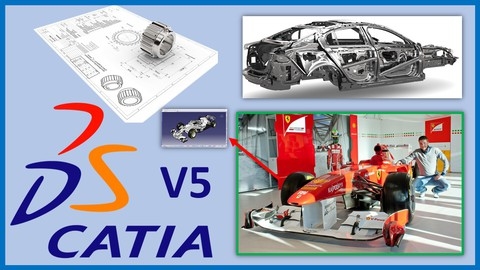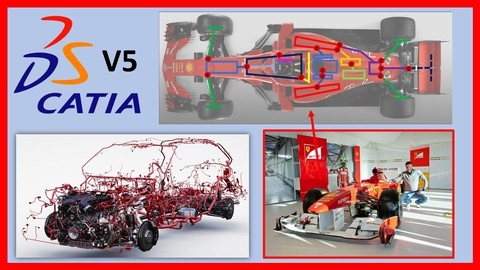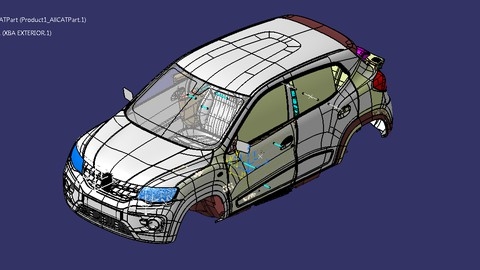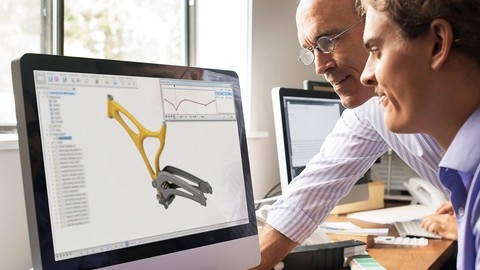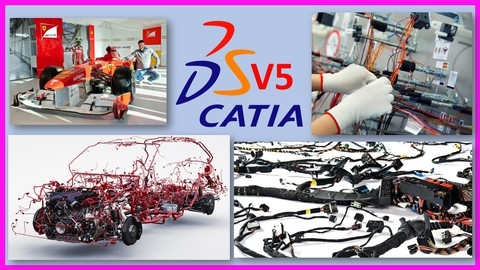Catia V5 is a powerful 3D CAD software widely used in various industries, particularly automotive and aerospace, for product design and manufacturing.
Learning Catia V5 equips you with the skills to create complex 3D models, assemblies, and drawings, making you a valuable asset in today’s competitive engineering landscape.
With Catia V5 proficiency, you can design everything from intricate car parts to entire aircraft, opening doors to exciting career opportunities in engineering, design, and manufacturing.
Finding a high-quality Catia V5 course on Udemy can be overwhelming, given the abundance of options available.
You’re looking for a comprehensive course that covers both the fundamentals and advanced techniques, providing hands-on exercises and real-world projects to solidify your understanding.
You want to ensure you’re investing in a course that will effectively equip you with the skills you need to excel in using Catia V5.
For the best Catia V5 course overall on Udemy, we recommend the Catia V5 Beginner to Advanced - Automotive and Industrial course.
This comprehensive course provides a structured learning path, starting with the basics and progressing to advanced topics like surfacing and assembly design.
It also includes practical projects, allowing you to apply your knowledge and build a strong portfolio.
While the Catia V5 Beginner to Advanced - Automotive and Industrial course is our top pick, there are several other excellent Catia V5 courses available on Udemy, each catering to specific needs and skill levels.
Keep reading to explore our recommendations for beginners, intermediate learners, and those interested in specialized areas like electrical harness design or automotive product design.
Catia V5 Beginner to Advanced - Automotive and Industrial
If you’re looking to master Catia V5 for automotive and industrial design, this course provides a structured path from beginner to skilled professional.
You’ll start with the fundamentals, understanding the software interface, navigating menus and toolbars, and utilizing essential tools like STEP files for collaboration.
The course then delves into the crucial skill of sketching, where you’ll master precise 2D drawings.
You’ll learn to create intricate curves for aerodynamic car designs, apply complex constraints, and use advanced sketch operations to bring your ideas to life.
Moving on to part design, you’ll delve into creating complex 3D components.
You’ll learn to utilize powerful features like pads, pockets, holes, and shafts to design intricate parts for vehicles and machinery.
You’ll also learn to apply fillets and chamfers to create aesthetically pleasing and functional designs.
Next, you’ll learn to assemble your parts into complete products, gaining proficiency in applying constraints and managing the assembly structure.
You’ll also master techniques for clash detection and sectioning, crucial for creating robust and error-free designs.
The course emphasizes drafting techniques, teaching you to create professional-looking drawings that communicate your designs effectively.
You’ll learn to create precise views, dimensions, and annotations, ensuring clear and accurate documentation for your work.
Through a series of practical projects, you’ll design real-world applications, such as a lamp, a tow ball mount, and a frame with drawers.
These projects solidify your understanding of the concepts learned and prepare you for tackling industry-specific challenges.
This course offers a comprehensive approach to Catia V5, equipping you with the necessary skills to create and develop innovative designs in the automotive and industrial sectors.
You’ll be prepared to confidently tackle complex projects and take your design career to the next level.
CATIA V5 Mastery: 500 Examples| 20 Project| 300 Q&A| 10 Test
The syllabus is structured logically, taking you from the fundamental concepts of sketching to advanced techniques for building complex assemblies and generating professional drawings.
You’ll start your journey in the Sketcher Workbench, where you’ll learn to create 2D sketches with precision.
You’ll master essential tools like lines, circles, arcs, and constraints, and practice using them in over 50 detailed practice examples.
Next, you’ll transition to the Part Design Workbench, where the focus shifts to solid modeling.
Here, you’ll learn to build 3D parts using features like Pad, Pocket, Hole, and Fillet.
You’ll explore various fillet types, including edge fillets, chamfers, and face-face fillets, giving you the flexibility to create designs with varying levels of detail and complexity.
The course then dives into the world of 3D WireFrames and Surface Design, equipping you with the knowledge to create wireframe models and master surface design techniques.
You’ll explore features like Extrude, Revolve, Sweep, and Blend, which enable you to create complex shapes and surfaces.
These techniques are essential for creating realistic and intricate designs in a wide range of applications.
The Assembly Module provides a hands-on learning experience, guiding you through assembling individual parts into functional units.
You’ll work through several projects, including assembling a Valve Assembly and a Drone.
This real-world application of your skills will solidify your understanding of applying constraints and manipulating parts in a 3D environment.
Finally, you’ll learn about the Drafting Workbench, where you’ll develop the skills to generate professional drawings from your 3D models.
You’ll create various views, including orthographic views, auxiliary views, sectional views, and detailed views.
This comprehensive approach ensures you can effectively communicate your designs to others.
The course also includes five industrial projects focusing on designing parts for a Gas Turbine Engine.
This real-world application of your skills will challenge you and provide valuable experience in a highly technical field.
This course is packed with valuable content and features a strong emphasis on hands-on learning.
The combination of practice examples, projects, and industrial applications provides a comprehensive approach to mastering CATIA V5.
You will gain the skills and knowledge needed to confidently tackle real-world design challenges.
Catia V5 Electrical Harness Design - Automotive & Industrial
This course offers a strong foundation in the fundamentals of electrical part design, equipping you with the knowledge to define crucial components like connectors, contacts, and shells.
You will also learn how to define mounting equipment, cavities, and termination points, ensuring you create a well-organized and functional harness.
The course then guides you through the practical application of this knowledge using the Electrical Assembly Design workbench.
You will learn to connect and disconnect electrical devices, define electrical device and connection points, and understand the importance of a robust electrical product structure.
You will discover how to create wire bundles with local slack management and master the nuances of bundle automatic updates.
The course shines in its practical examples.
Through the design of a motorsport harness, you will experience a complete design process, from planning and establishing connections to routing wire bundles and adding supports.
This real-world application provides valuable insight and reinforces the theoretical concepts you have learned.
You will explore the nuances of automotive harness design for mass production, gaining expertise in automotive connectors, harness construction materials, and the various families and inline connections used in this field.
You will also gain a unique perspective on the world of Formula One, motorsport, aircraft, and military & defense electrical harnesses, opening doors to diverse career paths.
You will delve into the critical process of electrical harness flattening, learning how to make connections, define flattening parameters, and extract the harness for flattening.
You will explore various techniques such as arranging junctions, bending branches, and adjusting parts for optimal results.
This knowledge will prepare you for real-world manufacturing scenarios.
This Catia V5 Electrical Harness Design course equips you with the comprehensive skills and knowledge needed to design electrical harnesses for diverse applications.
It provides a strong foundation in the fundamentals of electrical part design, real-world application through practical examples, and detailed knowledge of automotive and industrial harness design.
With its emphasis on both theoretical understanding and practical application, this course offers an effective path to mastering Catia V5 for electrical harness design.
Complete Course in CATIA
This “Complete Course in CATIA” syllabus offers a structured and thorough introduction to the software, targeting aspiring users eager to gain proficiency in CAD modeling and design.
You’ll begin your journey by familiarizing yourself with CATIA’s fundamental tools and settings, gaining the groundwork for success.
The syllabus then dives into the Sketcher Workbench, where you’ll master the art of creating accurate sketches using tools like circle, arc, and line tools.
You’ll also learn to apply constraints to ensure precise geometric control, a crucial skill for building accurate models.
As you progress to the Part Modeling Workbench, you’ll transform your sketches into 3D representations.
You’ll learn to add and remove material, create intricate holes, and apply fillets and chamfers for realistic and polished designs.
This module also introduces you to a range of transformation tools, enabling you to manipulate objects with ease, mirroring, rotating, and translating them with precision.
The Surfacing (GSD) Workbench expands your skillset by focusing on creating complex and intricate shapes.
You’ll learn to use wireframe tools to create a foundation for your surfaces, then apply techniques like sweep, blend, and multi-section to build the desired form.
You’ll also master surface operations such as joining, trimming, and splitting, allowing you to refine and manipulate your creations with complete control.
The Sheetmetal Workbench introduces the fundamentals of sheetmetal design, a vital area for many industries.
You’ll learn to create walls, flanges, and bends with confidence, applying tools for folding, unfolding, and manipulating sheetmetal parts.
The course concludes with the Assembly Workbench, where you’ll learn to combine multiple parts into a single assembly, applying constraints, analyzing degrees of freedom, and generating an exploder view for clear and informative presentations.The syllabus culminates in practice tests, providing valuable opportunities to test your knowledge and ensure you’re ready to apply your newly acquired skills in real-world applications.
Automotive product design using CATIA V5
This comprehensive course in automotive product design using CATIA V5 equips you with the skills to create detailed and realistic car parts, taking you from the initial design phase to manufacturing-ready models.
You’ll master the art of Class A surfacing, a fundamental skill for creating elegant and functional automotive designs.
You’ll dive into the intricacies of injection molding, learning to design plastic parts for vehicles, understanding crucial concepts like draft analysis and surface texture to ensure optimal manufacturability.
You’ll also design a complete injection-molded seat recliner, taking it from concept to finished product.
This hands-on project will solidify your understanding of core and cavity design, parting line creation, and the application of advanced design guidelines for injection molding.
You’ll also gain valuable experience in designing for assembly, ensuring your components seamlessly integrate into larger automotive assemblies.
You’ll learn to use clip towers and other structural elements to create strong and reliable connections.
Beyond individual components, you’ll explore the complexities of larger automotive parts, like belly pans for motorcycles.
You’ll learn to apply your knowledge to real-world scenarios, analyzing designs for factors like head impact resistance and wall thickness, ensuring your creations meet industry standards for safety and performance.
CATIA V5 Basic to Advance Interior Exterior Surfacing
You’ll begin with the fundamental building blocks of 3D modeling, delving into the intricacies of sketching and understanding constraints.
You’ll learn to leverage CATIA’s powerful sketching tools to create precise drawings, a crucial foundation for any successful 3D model.
The course then delves into the heart of CATIA’s capabilities with Part design, where you’ll master the art of creating complex parts using Boolean operations like union, intersection, and subtraction.
You’ll gain proficiency in manipulating and shaping your designs through the use of transformation features, adding intricate details and complexities to your creations.
This is where you’ll truly experience the power of CATIA, utilizing operations like Draft, pattern command, and multi-section to build increasingly sophisticated parts.
You’ll discover the versatility of guide curves and coupling, mastering these techniques to achieve complex and intricate designs.
As you progress, the course introduces you to the Assembly workbench, where you’ll learn to seamlessly assemble your individual parts into complete, fully functional products.
You’ll gain a clear understanding of the distinction between “add” and “assemble” commands, unlocking the ability to manipulate your designs with precision.
You’ll also master techniques for remastering or reverse engineering, skills that are highly valued in various design roles.
You’ll put these skills into practice through hands-on exercises, building real-world components like foot cover frames and foot frames, gaining practical experience that will prepare you for the demands of the industry.
But the real transformation occurs when you explore the intricacies of basic surfacing, a skill that brings your designs to life with unparalleled realism.
This section introduces you to surface remastering and the versatile Wrap surface command, tools that enable you to create incredibly detailed and lifelike surfaces.
You’ll delve into the world of A2B or Plastic design, a critical component of automotive design, learning to create everything from intricate side shields to functional cup holders.
You’ll gain a deep understanding of tooling analysis, B surface creation, and the process of generating realistic side shields.
You’ll even have the opportunity to apply your newfound knowledge by tackling a real-world project – designing a Recline handle – a hands-on experience that solidifies your understanding of the design process.
The course then shifts its focus to the practicalities of the design profession, preparing you for a successful career.
You’ll master the art of drafting and basic gd&t, learning to create technical drawings that effectively communicate your design vision.
You’ll be equipped for interviews with confidence, thanks to the course’s comprehensive interview preparation section, covering everything from question answers to the intricacies of the interview process.
You’ll gain invaluable insights into the world of seating design, understanding the technical aspects of SEATING OVERVIEW and mastering the art of gap & flush analysis, essential skills for any automotive designer.
You’ll leave this course with a complete understanding of the design process, from sketching to assembly, and be prepared to launch a successful career in the exciting world of automotive design.
CATIA V5 course for beginners
This CATIA V5 course for beginners lays a strong foundation for anyone looking to learn this powerful 3D design software.
You’ll start with the fundamentals, mastering the user interface, navigation, and key functionalities like mouse controls and workbenches.
This comprehensive approach ensures you feel comfortable navigating CATIA before diving into more complex features.
The course dives into sketching, which is the heart of any 3D design.
You’ll learn to create sketches with various geometric constraints and dimensions, building a solid understanding of how to create precise and accurate 2D representations.
The Part Design workbench then takes you through creating solid models using a variety of features.
You’ll learn to create pads, pockets, holes, and apply draft angles, fillets, and chamfers – essential techniques for building robust and functional parts.
The course also covers advanced techniques like patterning and mirroring, allowing you to efficiently create complex and repetitive designs.
The Assembly Design workbench is where you’ll learn to build complex assemblies from the parts you’ve created.
You’ll master constraints, perform manipulations like snapping and smart moving, and utilize tools like explode and update to efficiently manage and manipulate your assemblies.
You’ll also learn about crucial features like clash detection, enabling you to anticipate and prevent design issues before they arise.
The Drafting workbench focuses on creating professional technical drawings from your 3D models.
You’ll gain mastery in creating various views, from front and top to isometric, and effectively apply dimensions and annotations.
The course also introduces you to tools like center lines, threads, and balloons, ensuring your drawings are clear, precise, and easy to understand.
Finally, the Generative Shape Design workbench introduces surface modeling, enabling you to create complex and organic shapes that are often difficult to achieve with solid modeling.
You’ll learn to use features like extrude, revolve, and sweep, and master editing techniques like trimming, splitting, and filling, giving you the freedom to shape your ideas into reality.
This course provides a well-structured foundation in CATIA V5, covering both basic and advanced concepts.
Catia V5 Electrical Harness Design - Automotive Projects
If you’re serious about breaking into the automotive electrical harness design field, this CATIA V5 course is a must-have.
It’s not just a basic introduction; it’s a comprehensive dive into the intricacies of 3D harness design.
You’ll start by mastering the fundamentals of component selection, understanding the different types of connectors, wires, relays, and fuses used in automotive applications.
You’ll also learn the importance of choosing the right components based on specific criteria – a skill that’s essential for efficient and reliable harness design.
But this course goes beyond theory.
You’ll gain hands-on experience with practical design challenges.
You’ll learn to position connectors accurately, route complex wire bundles with precision, and calculate bundle diameters for optimal performance.
You’ll also master techniques for adding slack to accommodate movement and vibration, ensuring your harness can withstand the rigors of the automotive environment.
This course pushes you further with projects that mirror real-world scenarios.
You’ll design a main cabin electrical harness, an underbody harness, and you’ll even tackle advanced topics like connector detailing, harness dynamics, and implementing Poka Yoke principles to prevent design errors.
This in-depth training ensures you’ll graduate with the skills and knowledge needed to tackle even the most demanding design challenges.
The course provides invaluable advice on building a compelling CV and portfolio.
You’ll learn how to showcase your experience in the best light and how to ace an interview, positioning yourself for success in the competitive automotive industry.
